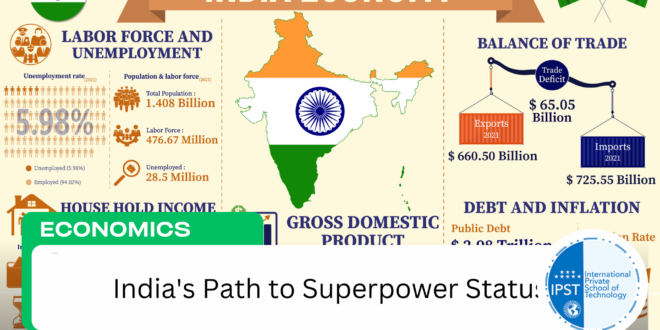Introduction
In the last two decades, India has undergone a massive economic transformation. From being a country with a struggling economy to one of the fastest-growing major economies in the world, India has certainly attracted global attention. As of now, India ranks as the world’s fifth-largest economy by nominal GDP. But the question remains: can India continue this growth trajectory and become the next superpower of the world?
In this article, we will explore the current state of India’s economy, the challenges it faces, and the opportunities that could pave the way for it to rise as a global superpower in the 21st century.
India’s Economic Growth: A Rapid Surge
India’s economy has been on an impressive growth streak, especially in the last decade. Between 2010 and 2020, India saw a remarkable increase in its GDP, becoming one of the largest economies by purchasing power parity (PPP). The country’s GDP growth rate has consistently outpaced many other developing nations, driven by a burgeoning middle class, rising foreign investments, and a young, dynamic workforce.
Key drivers of India’s economic success include:
- Services Sector Expansion – India has become a global hub for IT services, business outsourcing, and software development. Indian companies like Infosys, TCS, and Wipro have made their mark on the global stage.
- Manufacturing Growth – The “Make in India” initiative, launched in 2014, has spurred growth in the manufacturing sector, aiming to make India a manufacturing powerhouse by attracting foreign investment.
- Youthful Demographics – With over 50% of the population under the age of 25, India boasts a young and vibrant workforce. This demographic dividend provides the country with the potential for innovation, productivity, and economic expansion.
- Urbanization – Rapid urbanization has fueled demand for infrastructure, housing, and services, contributing to economic growth.
Challenges India Faces
Despite the positive growth outlook, India still faces several challenges that could hinder its rise to superpower status. Some of these include:
- Inequality and Poverty – A significant portion of India’s population still lives in poverty, and income inequality remains a pressing concern. Addressing these issues will be critical to achieving sustainable growth.
- Infrastructure Deficiencies – While the country has made progress, infrastructure remains inadequate in many regions, affecting everything from transportation to sanitation and power supply.
- Bureaucratic Hurdles – India’s complex regulatory environment can slow down business operations, discouraging both local entrepreneurs and foreign investors.
- Environmental Sustainability – India is also grappling with air pollution, water scarcity, and environmental degradation, which threaten its long-term economic stability.
Can India Become a Superpower?
India’s potential to become the next superpower lies in several factors, both domestic and international. These factors, when leveraged, could make India a key player on the global stage.
- Strategic Partnerships – India’s growing diplomatic influence in Asia and beyond, coupled with its strategic partnerships with countries like the United States, Japan, and Australia, enhances its global stature. It is also an important member of international organizations like the BRICS, G20, and the United Nations.
- Technological Advancements – India is rapidly advancing in areas like space exploration, artificial intelligence, and digital infrastructure. With continued investments in research and development, India could establish itself as a leader in global technology innovation.
- Global Trade Influence – India is positioning itself as a major player in global trade. With a large consumer market and growing trade relations, India’s role in the global economy will continue to rise. Trade agreements with other countries will further boost its influence.
- Geopolitical Importance – India’s strategic location in Asia, bordering China and being part of the Indian Ocean region, enhances its geopolitical importance. As China’s influence grows, India’s role as a balancing power is likely to increase.
The Road Ahead: What India Needs to Focus On
To achieve superpower status, India must focus on several critical areas:
- Education and Skill Development – Investing in education and skill development to ensure the young workforce can meet the demands of a knowledge-driven economy is crucial.
- Sustainable Development – India must prioritize environmental sustainability and address challenges like pollution and resource depletion to ensure long-term growth.
- Economic Reforms – Streamlining regulations, improving ease of doing business, and fostering innovation will be key to sustaining high levels of investment and growth.
- Inclusive Growth – Reducing poverty and inequality by creating opportunities for all segments of society will be essential for India to truly prosper as a global leader.
Conclusion
India has a significant opportunity to rise as the world’s next superpower, driven by its dynamic economy, strategic positioning, and ambitious goals. While challenges remain, India’s economic trajectory, fueled by a youthful workforce, technological advancements, and expanding global influence, makes it a compelling candidate for superpower status in the coming decades.
India’s rise, however, will depend on addressing its internal challenges while maximizing its strengths on the global stage. If it continues on this path, India could indeed become one of the most influential nations in the 21st century.
This article presents a comprehensive look at India’s economic growth, its potential for becoming a superpower, and the factors that could shape its future success.
 International Private School of Technology المدرسة الدولية الخاصة للتكنولوجيا Private School مدرسة خاصة للتكوين المهني
International Private School of Technology المدرسة الدولية الخاصة للتكنولوجيا Private School مدرسة خاصة للتكوين المهني


